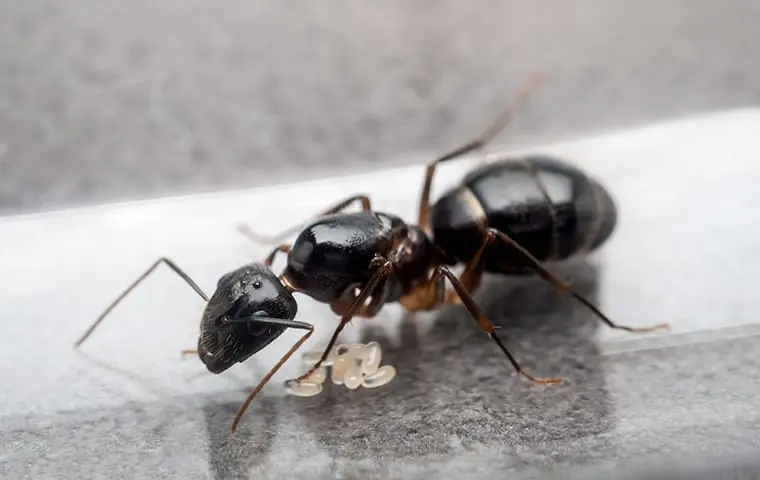
However, along with the joys of the changing seasons, unexpected visitors can also be eager to stake their claim on your living space.
One such unwelcome guest is the carpenter ant, a formidable foe that can infiltrate even the most seemingly secure areas of your home, including window casings and sills.
Join us as we delve into why you may see carpenter ants in window casings and unveil effective strategies to keep them at bay.
A Misidentified Invasion
Picture this: a Raleigh, NC homeowner, captivated by the hints of early spring, notices a flurry of activity near their kitchen window sill. Alarmed, they suspect a termite swarm, a scenario that can cause anxiety for any homeowner. In a panic, they reach out for help, and that’s when the experts from Innovative Pest Solutions step in!
Contrary to the homeowner’s initial assumption, the culprits behind the window-sill commotion are not termites but carpenter ants. This confusion is common, particularly during the transitional months when temperatures rise.
When the weather gets hot, carpenter ants can leave their hiding places, thinking spring has arrived early thanks to the sun shining through the windows.
Understanding Carpenter Ants
Despite their size, carpenter ants are skilled architects of the insect world. They have a knack for selecting wood softened by moisture, making it an ideal spot for their colonies to thrive. In places like Raleigh/Durham, where the air is often humid, these ants find plenty of chances to create their intricate nests within the nooks and crannies of windows.
These ants are experts at tunneling through wood, crafting extensive networks of passages with remarkable precision. Unfortunately, their diligent excavation can take a toll on the structural integrity of your home. Over time, as they continue to burrow and expand their colonies, the wooden supports of your home can weaken, potentially posing a threat to its overall stability.
But what makes them different from termites?
Carpenter ants and termites, often confused due to their wood-damaging tendencies, are distinct insects with different characteristics. Carpenter ants, larger and with segmented bodies, don’t consume wood but carve galleries within it to establish nests. That’s why you often see carpenter ants in window casings or sills.
Their foraging habits extend to sugars, proteins, and other insects. Termites, smaller and with soft, cream-colored bodies, feed on wood by breaking down cellulose with the help of specialized gut bacteria. They construct mud tubes on wood surfaces for protection and can cause substantial structural damage.
While both insects can leave behind wood shavings, the critical difference lies in their behavior and infestation signs. Carpenter ants create smooth tunnels and discard wood shavings neatly, often accompanied by dead ant parts.
Termites, however, build mud tubes and leave honeycombed or layered wood behind as they feed. If infestations are suspected, professional pest control guidance is crucial to identify the insect and initiate effective control measures accurately.
Combatting Carpenter Ants in Window Casings
So, what can homeowners do to thwart the advances of these tenacious invaders? Keeping carpenter ants at bay requires a multi-faceted approach addressing prevention and eradication. When you have carpenter ants in window sills, you must act fast and follow these helpful steps!
- Maintain Gutters and Caulking: Carpenter ants thrive in areas with moisture-rich wood. By diligently maintaining your gutters and ensuring that exterior caulking remains fresh and intact, you create a less hospitable environment for these pests. This simple step can go a long way in safeguarding your home.
- Replace Rotted Wood: Any signs of rotted or softened wood should not be ignored. Promptly replacing such wood with healthier alternatives eliminates potential nesting sites and preserves your home’s structural integrity. Plus, it’ll help remove any carpenter ants in your window casings.
- Professional Intervention: In cases where carpenter ants have already established a presence, seeking professional assistance is crucial. As experts like Innovative Pest Solutions understand the behavior and habits of these ants, we can apply targeted treatments to eradicate colonies effectively.
- Vigilance: It is beneficial to conduct routine inspections of the exterior of your home to detect any indications of carpenter ant activity at an early stage. Such signs may include the appearance of tiny wood shavings or the presence of the ants themselves.
Embracing a Pest-Free Haven
As winter gives way to spring, many are eager to enjoy the great outdoors. However, we’re not the only ones excited about the changing seasons. Carpenter ants tend to invade windows and sills, which can make us feel uneasy.
Homeowners can keep their living spaces peaceful and free of pests by being proactive, focusing on areas prone to moisture, and seeking professional help. So, as nature awakens and the sun shines brighter, take steps to safeguard your home against these manageable foes. With some planning and expert guidance, you can embrace the season without worrying about unwanted intruders disrupting your space.
Contact us at the first sign of carpenter ants!





